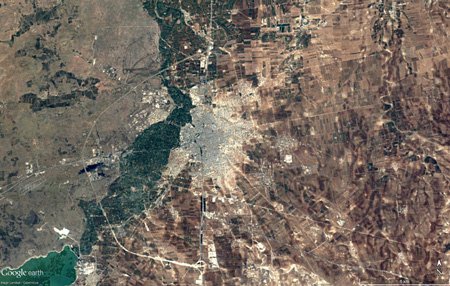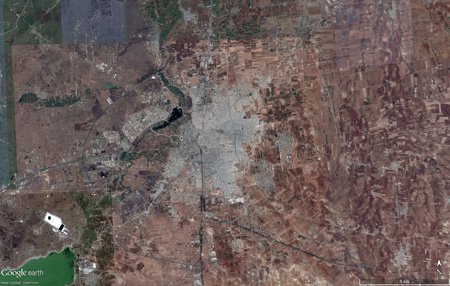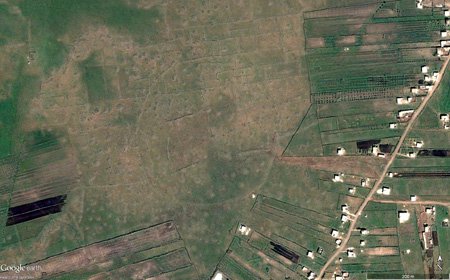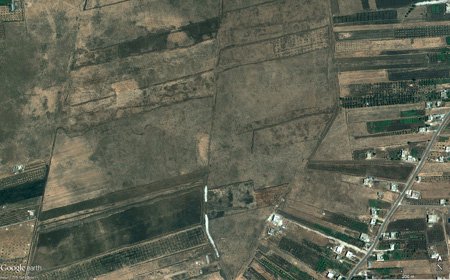Agriculture in the Fertile Crescent, from the deep past to the modern conflict
by Jennie Bradbury & Philip Proudfoot
- Date
- 21 Jun 2018
Published in British Academy Review, No. 33 (Summer 2018).
The print version of this article can be downloaded as a PDF file.


Dr Philip Proudfoot is Vice Chancellor’s Research Fellow in Global Challenges at Northumbria University.
The Middle East is famed as the birthplace of farming – and agriculture, pastoralism and settlement are tightly interwoven across it. People’s livelihoods are dependent on these practices, and the ways in which populations can exploit the land have affected conflict and settlement for thousands of years. These factors also represent some of the most significant threats to the natural and cultural heritage of this region. Amidst on-going conflicts in the area, can an exploration of the agrarian origins of these uprisings lead to a better understanding of the current conflict and the post-conflict future of this region? [note 1]
An agrarian uprising in Syria?
In March 2011 when anti-government protests found footing in Syria, they did not begin in the country’s major urban centres of Aleppo or Damascus but in the rural cities, towns and villages of Deir Ezzor, Dara’a, Homs, Hama, and Hasakah. Popular discontent in Syria’s agricultural hinterlands was evidently high, yet the bulk of mainstream analysis continues to view the conflict as mostly sectarian (Sunni versus Shia/Alawi) or political (democracy versus authoritarianism). This has led to peace-building strategies that fixate on the challenges of ‘post-conflict governance’ (free and fair elections and new constitutions) or future ‘sectarian balancing’ (federalism and confessional democracy). What has been sidelined is the collapse of rural livelihoods, leaving the socio-economic grievances that sparked the uprising largely unaddressed.
According to official government statistics, Syrian agriculture employed 19.5 per cent of the country’s population in 2005–6; others have estimated a number closer to 40-50 per cent. On the eve of the uprising, the agricultural sector witnessed a significant decrease in rural jobs. According to UN labour force surveys, 460,000 people stopped working in the sector between 2001 and 2007, representing a 33 per cent decrease in jobs. Alongside rural unemployment, a large number of poverty-belts had begun to surround major Syrian cities, composed of displaced farmers seeking work in the city. Such features are a familiar sight across the Middle East, but in Syria they were a relatively recent phenomenon, having sprung up mostly from the mid-2000s onwards. The militarisation of the Syrian uprising has meant that many young men from these rural areas and impoverished slums have become increasingly dependent on the war economy, and therefore appear easy targets for the conflict’s Islamist recruitment networks.


Where conflict analysts have admitted agricultural decline and urbanisation were a triggering factor for anti-government resentment, they have tended to allot a disproportionate percentage of blame on ‘external environmental factors’, in particular the 2006–2010 drought. However, a number of agronomists have responded that the drought – while doubtless an accelerating factor – must be seen in the context of Syria’s increased pace of liberalisation and reform carried out under Bashar al-Assad, alongside at least 50 years of water resource mismanagement. Rapid economic liberalisation from the mid-2000s onwards brought rising levels of inequality, as well as the cancellation of input/output agricultural subsidies. Philip Proudfoot’s research has documented how, in this context, Syrian labour migration to Lebanon shifted from a temporary means to make some extra cash, to a survivalist mechanism.
Drought has always been a central feature of the Fertile Crescent’s semi-arid climate. Between 1961 and 2009, Syria experienced nearly 25 years of drought. In 1961, the drought was so severe that 80 per cent of the country’s camel stock was lost, and 50 per cent of sheep stocks. Data from the International Food and Policy Research Institute shows that the frequency of droughts had not increased prior to 2011, but populations in drought-affected areas reported a perception that droughts had increased. One explanation for this is that higher population densities, and the depletion of ground water resources, had made the drought significantly harder to mitigate. Given Syria’s high-levels of rural discontent on the eve of the uprising, it is perhaps surprising that very few major peace-building initiatives have concentrated on the specific development challenges faced by Syria’s rural provinces. The bulk of ongoing NGO and academic-led research focuses around ongoing priorities, such as government-level refugee management, shelter improvement technology, and refugee policy-critique. This risks missing the need to begin immediate planning for post-conflict rural Syria. Indeed, should the country simply return to its pre-war path of high input industrialised farming, poor water management, and unrestricted grazing practices, then a further humanitarian crisis is almost inevitable. In short: this will not produce a socio-political fabric conducive to peace.
The UN Food and Agriculture Organization pinpointed the high degree of wartime damage wrought against Syria’s agricultural infrastructure [note 2]. Nonetheless, it has also been careful to note that agriculture is typically one of the most resilient economic sectors, and with the right support it is able to bounce back from conflict more rapidly than other industries. Experiments carried out by Italian researchers in the Al Talila reserve have shown that in protected enclosures, where livestock grazing was forbidden, vegetation quickly recovered. Enclosed areas became green pastures, while the desert continued to spread outside. As for farming, one of the main issues is Syria’s reliance on high-input non-native grains, flood irrigation, and chemical fertilisation. When the government suddenly withdrew subsidisation in the mid-2000s, many farmers simply found that their land was no longer profitable. These industrial-farming practices contributed toward a growing water deficit of around 3.59 billion cubic meters, which, on the eve of the uprising, was already being compensated through dam reserves. Officially, the UN re-classified Syria as a water-scarce country.
Does agriculture threaten or preserve the past in the Middle East?
Since the beginning of the conflict in Syria, Libya and Yemen, archaeologists and heritage specialists from across the globe have been involved in initiatives to document and safeguard the heritage of this region for the future. This work ranges from the collation of large datasets and websites designed to combat looting and trafficking activities [note 3], to projects recording previously known and unknown sites, and the different types of disturbances and threats affecting them [note 4]. Ongoing archaeological fieldwork projects are now also starting to integrate risk and condition assessments on a much more regular basis. For example, fieldwork in northern Lebanon – funded by the Council for British Research in the Levant (CBRL) – has been documenting the condition of rural sites as part of ongoing research.
In Syria, archaeological fieldwork (2007-2010) to the northwest of the modern city of Homs (Syria), carried out as part of the Syrian-British landscape project ‘Settlement and Landscape Development in the Homs Region’, integrated basic information on the preservation of the archaeological sites it was documenting. Since then we have virtually revisited this area, and using historic photographs and satellite imagery, tried to assess the time scale over which sites in this region were destroyed. From this work we estimate that over 60 per cent of the archaeological features that we had identified on satellite imagery from the 1960s and ’70s had been either partly or totally destroyed by 2002.
As opposed to conflict-related activities, the main agent of destruction seems to have been related to the expansion of agriculture. ‘De-rocking’ operations using heavy machinery, often bulldozers, with the intention of increasing the cultivable area, have led to widespread destruction. This type of clearance destroys even substantial surface and sub-surface archaeological features, creating large open fields, bordered by huge basalt boulder field walls. These ‘de-rocking’ initiatives were originally supported by development organisations, and aimed at increasing agricultural productivity. They are widely adopted at a local level, often on a ‘freelance’ basis and with little technical or administrative oversight. The increase in these activities from the 1990s onwards has led to the destruction of hundreds of archaeological sites and features.


Agriculture and pastoralism can affect archaeological sites and features in a variety of different ways. Ploughing, for example, can displace artefacts close to the surface, and also lead to an increase in erosion, as the layer of protective topsoil is removed. The planting of orchards can also damage features or remains close to the surface; trees planted in individual holes can be a metre or so deep. As the trees grow they continue to cause structural damage to both standing and sub-surface remains. Due to population increase, falling water tables and increasing water scarcity, the irrigation networks associated with agricultural systems can also end up affecting huge areas of archaeological remains. Centre pivot irrigation, for example, involves pumping water from up to a depth of 1 kilometre to the surface. Flat circular fields are created, often leading to archaeological sites being cleared away in advance of cultivation. Even the grazing of animals can threaten archaeological sites, with animals moving and breaking up artefacts close to the surface and damaging standing structures.
Agriculture is, however, not just an agent of destruction. In some cases, small-scale cultivation can protect archaeological sites, or at least prevent sites from being further developed or destroyed due to modern construction and industry.
From the past to the modern conflict
In a post-conflict setting, the need for increased exploitation of the land is very likely to lead to the destruction of hundreds of archaeological sites in the rural zone. Moreover, just as the bulk of research on Syria has yet to grapple with the humanitarian issues likely to emerge from a renewed focus on high-input industrial farming, so the archaeological community, to date, has largely focused on the necessity of post-conflict reconstruction in the major cities and archaeological sites.
Until relatively recently, agricultural events or activities were important social occasions, creating bonds between local communities and the individuals within them. Increased mechanisation of agriculture and rural production from the 1950s onwards in Syria, Lebanon and beyond also meant that many of the traditional practices, such as charcoal production, milling, soap and pottery production, have now almost disappeared. So also have many of the crops and rural products that were once well known from these regions. For example, Syria’s landrace seeds are more environmentally resilient, less water-demanding, and often more nutritious than international imports.
More recently, a form of rural nostalgia has developed in many of these countries. For the urban elites, this has emerged as a desire to return to ‘nature’, with the development of rural initiatives and of biosphere and wildlife reserves in Lebanon, Jordan, and also in Syria prior to the conflict. For displaced rural populations, these memories of the historical practices [note 5] speak to a time of peaceful coexistence, more secured livelihoods, and cultural links to past.
Ensuring access to food and resources is going to be a vital part of Syria’s post-conflict future. As our research demonstrates, however, these strategies need to be sustainable. It is perhaps from Syria’s agrarian past that a solution can be found: a vision for the future that emphasises the importance of developing sustainable practices that protect rural livelihoods, but also ensure the survival of the rich cultural and natural heritage of the Middle East.
The Council for British Research in the Levant is one of the British International Research Institutes that are supported by the British Academy.
Notes
1. The research behind this article is supported by the Council for British Research in the Levant (CBRL). Thanks also go to the EAMENA Project (University of Oxford), SHR Project (Durham University), and the Honor Frost Foundation.
2. Food and Agriculture Organization of the United Nations, Counting the cost: Agriculture in Syria after six years of crisis (2017).
3. Trafficking Culture: researching the global traffic in looted cultural objects (http://traffickingculture.org/).
4. Endangered Archaeology in the Middle East and North Africa (http://eamena.arch.ox.ac.uk/).
5. For example, see www.youtube.com/watch?v=OXtHomQ_SBw&feature=youtu.be
How are we doing? Your feedback is important to help us shape future issues of the British Academy Review.
To provide reader feedback, please visit www.britishacademy.ac.uk/british-academy-review-feedback